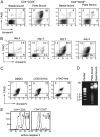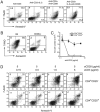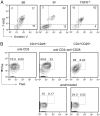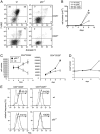CD4(+)CD25(+) regulatory T cells resist a novel form of CD28- and Fas-dependent p53-induced T cell apoptosis
- PMID: 19949106
- PMCID: PMC4436589
- DOI: 10.4049/jimmunol.0900753
CD4(+)CD25(+) regulatory T cells resist a novel form of CD28- and Fas-dependent p53-induced T cell apoptosis
Abstract
Ag receptor stimulation of preactivated T cells causes rapid cell death in an IL-2- and Fas-dependent manner. This phenomenon, known as activation-induced cell death (AICD), plays a pivotal role in the removal of Ag-reactive T cells after initial expansion. In this study, we report a novel form of T cell apoptosis that is distinct from classic AICD. When peripheral T cells were activated with anti-CD3 and anti-CD28 Abs precoated onto plastic plates, CD4(+)CD25(-) and CD8 T cells initially expanded but underwent massive apoptosis after 4 d. Unlike classic AICD, this type of T cell apoptosis pathway requires engagement of CD28 and expression of p53, a tumor-suppressor gene. The most striking feature of this form of apoptosis was regulatory T cell resistance. Under the same stimulating conditions, CD4(+)CD25(+) T cells grew continuously beyond 4 d. Consequently, when the entire CD4 population was cultured with plate-bound anti-CD3 plus anti-CD28 Ab, CD4(+)CD25(+)FoxP3(+) regulatory T cells outgrew nonregulatory T cells and expanded >7000-fold after 11 d. The data presented herein demonstrate a novel process of Ag-induced T cell death by sustained TCR and CD28 engagement and represent a simple and efficient procedure for the expansion of regulatory T cells in vitro.
Figures







Similar articles
-
Modulation of Fas-dependent apoptosis: a dynamic process controlling both the persistence and death of CD4 regulatory T cells and effector T cells.J Immunol. 2002 Jul 15;169(2):750-7. doi: 10.4049/jimmunol.169.2.750. J Immunol. 2002. PMID: 12097377
-
Increased numbers and suppressive activity of regulatory CD25(+)CD4(+) T lymphocytes in the absence of CD4 engagement by MHC class II molecules.Cell Immunol. 2013 Apr;282(2):117-28. doi: 10.1016/j.cellimm.2013.05.002. Epub 2013 May 15. Cell Immunol. 2013. PMID: 23770721
-
CD8+CD28- cells and CD4+CD25+ regulatory T cells in the peripheral blood of advanced stage lung cancer patients.Med Oncol. 2010 Mar;27(1):29-33. doi: 10.1007/s12032-008-9165-9. Epub 2009 Jan 16. Med Oncol. 2010. PMID: 19148592
-
Antigen-induced T cell death is regulated by CD4 expression.Int Rev Immunol. 2001 Oct;20(5):535-46. doi: 10.3109/08830180109045577. Int Rev Immunol. 2001. PMID: 11890611 Review.
-
CD8+ CD28- and CD8+ CD57+ T cells and their role in health and disease.Immunology. 2011 Sep;134(1):17-32. doi: 10.1111/j.1365-2567.2011.03470.x. Epub 2011 Jun 29. Immunology. 2011. PMID: 21711350 Free PMC article. Review.
Cited by
-
Cellular basis of tissue regeneration by omentum.PLoS One. 2012;7(6):e38368. doi: 10.1371/journal.pone.0038368. Epub 2012 Jun 6. PLoS One. 2012. PMID: 22701632 Free PMC article.
-
The Double Role of p53 in Cancer and Autoimmunity and Its Potential as Therapeutic Target.Int J Mol Sci. 2016 Nov 25;17(12):1975. doi: 10.3390/ijms17121975. Int J Mol Sci. 2016. PMID: 27897991 Free PMC article. Review.
-
Novel mucosal adjuvant, mastoparan-7, improves cocaine vaccine efficacy.NPJ Vaccines. 2020 Feb 5;5(1):12. doi: 10.1038/s41541-020-0161-1. eCollection 2020. NPJ Vaccines. 2020. PMID: 32047657 Free PMC article.
-
Host immune responses that promote initial HIV spread.J Theor Biol. 2011 Nov 21;289:17-35. doi: 10.1016/j.jtbi.2011.08.012. Epub 2011 Aug 22. J Theor Biol. 2011. PMID: 21871901 Free PMC article.
-
Preferential control of induced regulatory T cell homeostasis via a Bim/Bcl-2 axis.Cell Death Dis. 2012 Feb 9;3(2):e270. doi: 10.1038/cddis.2012.9. Cell Death Dis. 2012. PMID: 22318539 Free PMC article.
References
-
- Sakaguchi S, Yamaguchi T, Nomura T, Ono M. Regulatory T cells and immune tolerance. Cell. 2008;133:775–787. - PubMed
-
- Collison LW, Workman CJ, Kuo TT, Boyd K, Wang Y, Vignali KM, Cross R, Sehy D, Blumberg RS, Vignali DA. The inhibitory cytokine IL-35 contributes to regulatory T-cell function. Nature. 2007;450:566–569. - PubMed
-
- Pandiyan P, Zheng L, Ishihara S, Reed J, Lenardo MJ. CD4+ CD25+Foxp3+ regulatory T cells induce cytokine deprivation-mediated apoptosis of effector CD4+ T cells. Nat Immunol. 2007;8:1353–1362. - PubMed
Publication types
MeSH terms
Substances
Grants and funding
LinkOut - more resources
Full Text Sources
Molecular Biology Databases
Research Materials
Miscellaneous

